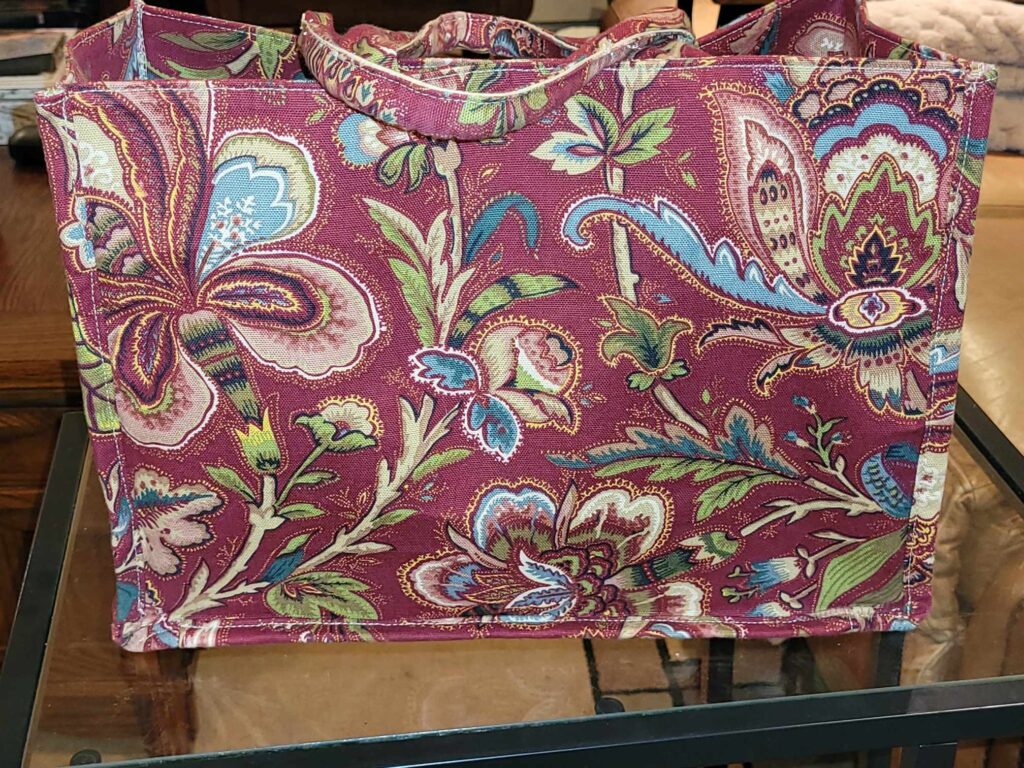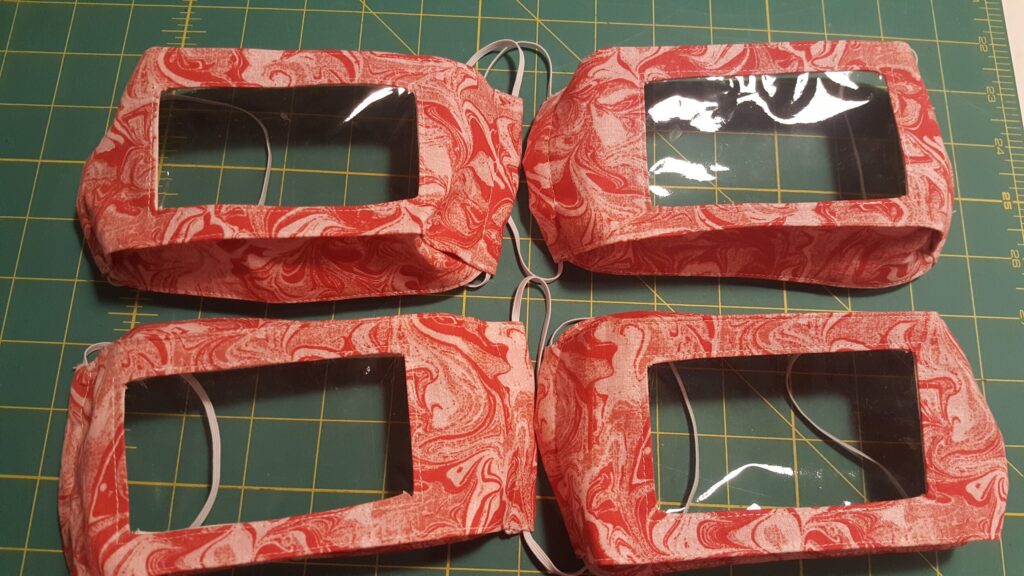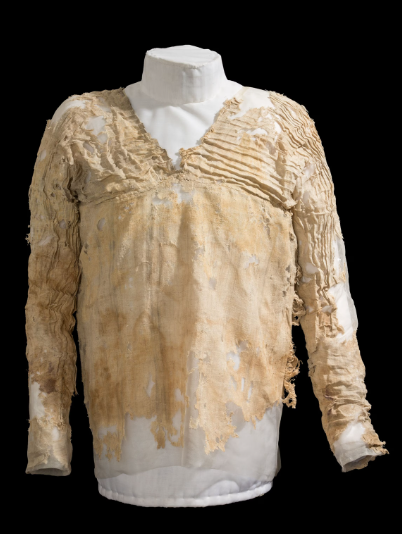I wish I could tell you I learned to sew at my grandmother’s knee. There is a small element of truth to that notion; my paternal grandmother was an accomplished sewist who made muslin dolls and doll clothes. Unfortunately, she was not much of a teacher and children were meant to be spectators until reaching driving age. So, let’s say I learned about sewing at my grandmother’s knee, but not necessarily the craft itself.
In fact, I did not take on sewing until I was well into adulthood, some might even say middle age, though I’d like to think that I was just nearing that boundary at the time and had yet to cross over. In all honesty, I took up sewing to make things that were nicer than I could afford. I love nice things. Lush, pretty, extravagant things. Clothing and home decorating. I love the kinds of clothes I can’t normally find either in my size, in this part of the country or both. I love fancy home decor. I made roman shades out of a nice Waverly print. They didn’t pull up and down with great ease, but they got the job done. I still have the fabric.

Now a book tote, this fabric’s brethren spent time as Roman shades.
The same could be said for how and why I learned to cook: there’s a tremendous gap between the kinds of restaurants I’d like to go to and those I can afford. So, I do know how to make a mean pastry creme and I have documented evidence I’ve made cream puffs. Once. Only once. I’ll figure out how to afford those.
During the pandemic, I saw an opportunity to supplement my non-existent income and must have made about 500 masks that I sold to the community. Maybe I’m exaggerating, but I lost count, and it certainly felt like 500. I made connections with people I still know today either personally, or on social media. The house became a factory: cutting on my desk, pressing in the TV room, serging in the back Rec Room, and sewing back here in my studio/office … ahem, excuse me, l’atelier.

These masks were made for those using lip-reading while communicating with those with hearing loss.
I really miss this fabric.
I took a hiatus during which I found myself back in the corporate world. That was fun, or so they said.
I found, however, that I missed sewing more than I expected. There’s something magical about taking an amorphous (yes, I know fabric is flat and rectangular off the bolt but work with my metaphor here) and giving it form, shape and function. There’s something I love about taking beauty and giving it more beauty.
Only, before I could revel in the magic, I needed to get all the stored boxes out of the sewing room first. And if you’d seen what all had been stored in here, you’d know that was no small feat. Herculean might be a word used in all fairness, had any outsiders been allowed to examine the scene. In the meantime, short sewing reels would pop up on my feed and I’d find myself excited by the sound of the sewing machine as the motor turned to move the presser foot along. I’d find myself almost hypnotized by the rapid-fire movement of the needle shaft up and down as some luxurious fabric moved forward along the machine bed. Watching factory sewists operate the robotic pressers and cutters filled me with awe.
While we’re talking about factory sewists, can we digress? Yes, we can. And we should.
As far as I’m concerned, factory sewists are skilled tradespeople just like masons, carpenters and a host of other skilled people who work with their hands. It seems though, that because sewing is predominantly associated with women, and exploitive labor practices, mass production of clothing is viewed with a bit of derision, as if anyone could do that on Day 1.
To those people I would ask: ever set in a sleeve? I hereby vow to all that is holy that setting in a sleeve is by far the most difficult, more-art-than-science part of sewing I have ever attempted. I’m an educated woman. My name is on scientific papers for crying out loud (and not as a test subject or clinical case). But for one dress, one sleeve took me over an hour, probably two, and I know there was wailing and gnashing of teeth involved, in Biblical proportions. Now whenever I see a factory video, and someone is at his or her factory station setting in five sleeves in five minutes I swear they need a medal. That’s skill. I don’t care how many robots are involved, getting that ease just right and not having any puckering on that armscye is an accomplishment. Getting that done multiple times an hour is downright Olympic.
While we’re on that topic, let’s not forget all the many people throughout pre-industrial history who did that by hand, and whose extravagant, detailed work stands in museums and historical collections to this day. In addition to them, the embroiderers and weavers who created textiles that have lasted centuries, while a modern tee shirt won’t last six washings.1
Skill. Craft. Ability.
This last bit perhaps brings me to something I love dearly about sewing (and even cooking, though I don’t really cook anymore). These are skills we, as a species, have had throughout our existence. According to word-archaeology.com and other sources, the world’s oldest fibers2, made of flax, date back to 30,000 or 34,000 years; some of the fibers were dyed. That’s the Upper Paleolithic era, aka the Stone Age. Humans had fabric and/or fibers — dyed cloth at that — in the stone age. For comparison, according to Wikipedia, the oldest ceramic we know about dates back to anywhere from 29,000 to 25,000 years ago. Here’s the context in terms of human civilizations: the first evidence of people in Japan goes back to about 40,000 – 35,000 years ago, only a few thousand years prior to the first discovered cloth. So, cloth and sewing must have been one of the first inventions of the human race. On the one hand, of course. Even the Bible says so. Without the art of transforming natural materials, be they fibers or hides, to coverings, we would have not survived. On the other hand, that’s impressive. We crawled out of the primordial ooze and figured out how to turn a bunch of wildflowers (flax)3 into cloth, and a high-functioning cloth at that. Yay us.
Then to consider how old the art of weaving and dying and shaping fabric are, that the complex clothing of the entire pre-industrial ages was even possible, not to mention crafted by hand, well, the brilliance of all of that astounds me. And I can barely set in a sleeve.

The Tarkin Dress dates back to around 3482-3102 BC, according to 2015 carbon dating. It is the world’s oldest articles of clothing discovered.
To read more, see:
The UCL Petrie Museum of Egyptian Archaeology
Archaeology.org, May-June 2016
Sometimes, when I’m at the sewing machine working, or cutting at the workbench, this history seeps through my imagination and takes my breath away. Even when sewing with my computerized domestic machine or my cast iron industrial, I am connected with men and women who held bone needles and flax thread hundreds of thousands of years ago. I’m connected to the artisans who clothed great minds ranging from Hypatia to Ada Lovelace Baron to the “common” working class like Vermeer’s milkmaid.
Some interesting article sources I found:
- Fibershed, a network of farmers and fiber artisans in California
- The Harvard Gazette, from 2009
- The Candadian CBC
1. Due not to the craftsmen and artisans involved in the process, but the governing corporate actors who dictate and create a process that creates manufactured obsolescence.
2. Some sources refer to this as the oldest “cloth” while others have a more restricted definition of the finding as “fibers.”
3. I looked up flax to find out what it is botanically speaking. Flax is a flowering plant that has been cultivated, since, well, forever. I cannot quickly find a source to date when we it was first cultivated. However, I think it’s safe to say that when humans discovered it, it was growing wild and cultivation had to come later.


Leave a Reply